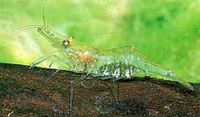Ghost Shrimp (Palaemonetes paludosus)
Ghost Shrimp
Palaemonetes paludosus
19 Litres (5 US G.)
5.1-7.6cm (2-3 ")
7.0 - 8.0
20 -29 °C (68-84.2°F)
3-10 °d
1:1 M:F
1-2 years
This animal is available captive bred
Contents
Alternative names[edit]
- Ghost Shrimp, Glass Shrimp, Grass Shrimp, Blue Banded Ghost Shrimp, Florida Ghost Shrimp, Guinea Floating Shrimp, Ivory Shrimp, Palenque Floating Shrimp, Paraguay Ghost Shrimp
Sexing[edit]
- Ghost shrimp can be sexed in a number of key ways. Females have a green saddle that runs along the underside of their belly while males do not. Females are also larger than the males and have a very pronounced ridge along the top end of the tail. They are easy creatures to breed, the females carry their green eggs on the underside of their carapace, they should be moved into a seperate tank if you wish the babies to survive, the young are too small to catch and so you must move the female while she is still carrying the baby ghost shrimp. It is essential to provide plenty of plants or other small hiding places in the aquarium for the young Ghost Shrimp. After the babies have hatched, the parent Ghost Shrimp should be removed. In order to successfully raise the young, they should be fed on baby brine shrimp, in addition to liquified (fry) food or minute algae.
Lifespan data[edit]
- Ghost Shrimp's lifespan is reported to be ~18 to 24 months.[1]
Tank compatibility[edit]
- Ghost Shrimp should not be housed with other species of shrimp. Keeping these shrimp with any fish which can fit the shrimp in its mouth, or with fish that prey on shrimp will result in the shrimp being eaten.
- Ghost Shrimp are opportunistic feeders, meaning they will also prey on other smaller shrimp.
Diet[edit]
Ghost Shrimp are detrivores and will consume algae (although uncommon), detritus and leftover food. If insufficient food is present, supplement with a quality flake food or pellet. It's not an effective algae eater.[2]
Feeding regime[edit]
- Ghost Shrimp have no special feeding instructions. One bottom feeder pellet per day will feed many shrimp. Care is warranted if these shrimp are to be exhibited in any tank with very small fish or fry. Although uncommon, they will attack and eat fry and very small fish if given the chance. These shrimp do not like algae pellets and much prefer a more carnivorous diet.
Environment Specifics[edit]
Ghost Shrimp do well in warmer temperatures, though they can survive in waters that are as cold as the upper 50 degree Fahrenheit range. It has been observed that in very warm temperatures, Ghost Shrimp become much more active, and they have been reported to become so aggressive as to attack fish in warm temperatures. In cooler temperatures, they are quite peaceful and it is the Ghost Shrimp who are in danger of fish attacks. Shrimp should have some plants to hide in, particularly if they are kept with fish that might eat them.
Behaviour[edit]
- Ghost Shrimps burrow to feed and digs its two to three-inch deep burrow with the claws of the first and second legs. It uses these legs to draw the sandy mud backward and collect it in a receptacle formed by another pair of legs. When the receptacle is full, the shrimp crawls backward, reverses itself in a special turn around chamber and then deposits its load outside. The burrows are not permanent. A number of branches and turnaround chambers are found in the burrows and they have at least two openings to the surface. The shrimp use their pleopods to produce some circulation of sea water through the burrows. The pencil-sized openings of the burrows are typically in the middle of little piles of sand or sand with small pebbles.
- All the legs are specialized with some being used for walking, some for bracing the animal in its burrow and others are used for personal cleaning. Ghost shrimp are always busy because if they stop digging then they start cleaning themselves or vice versa.
Identification[edit]
- Ghost Shrimp, also known as Glass Shrimp, are a relatively small invertebrate only reaching a maximum size of 1.5-3". Their bodies are transparent, and an orange to yellow colored spot is visible in the center of the tail. The body is segmented, and features ten sets of legs.
Special Note[edit]
- Because Ghost Shrimp are commonly sold as feeder animals, they are frequently mislabeled. The label will read 'Ghost shrimp' but you will be getting a random shrimp. Care should be taken as many feeder ghost shrimp are wild caught (frequently in Florida), and could carry pests. If you wish to breed these shrimp, or use them as a show piece, it is recommended that you pay a little more and buy from a more reputable breeder.
Pictures[edit]
Platies & Ghost Shrimp
References[edit]
- ↑ Lifespan data from The Conservation Management Institute (CMI) within the College of Natural Resources at Virginia Tech USA, Species Id M070010, 26 AUG 1996.
- ↑ The Aquarium Club


